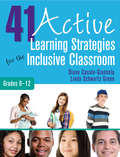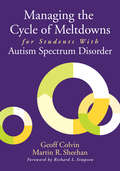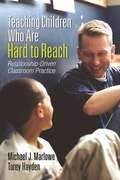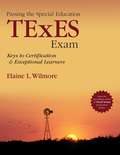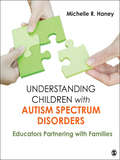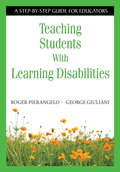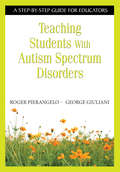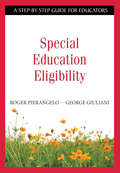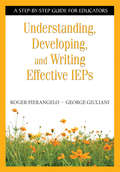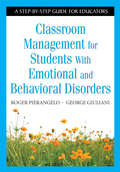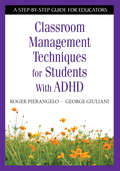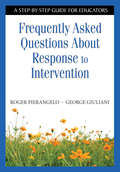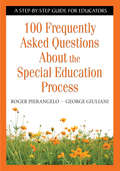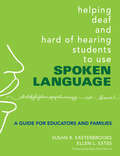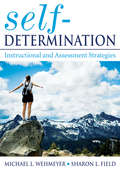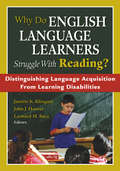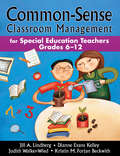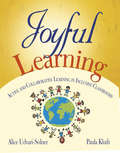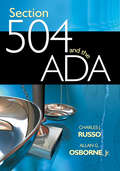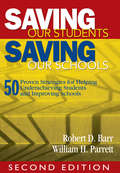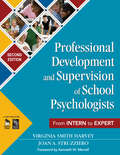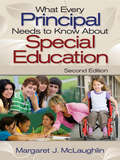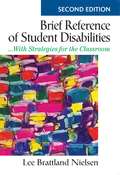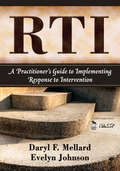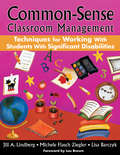- Table View
- List View
41 Active Learning Strategies for the Inclusive Classroom, Grades 6–12
by Diane P. Casale-Giannola Linda S. GreenKeys to engaging secondary students Research shows that all students—regardless of learning style, disability category, or language difference—learn more effectively when they are engaged in active learning. This book shows teachers how to help all students achieve positive learning outcomes. The authors provide a compilation of strategies that serve as blueprints for instructional design and directions for using them across a variety of content areas. The many benefits of active learning include: A more engaged and interactive classroom Increased self-directed learning Development of higher-order thinking skills such as analysis, synthesis, evaluation Improved reading, discussion, and writing competencies
Managing the Cycle of Meltdowns for Students With Autism Spectrum Disorder
by Geoffrey T. Colvin Martin R. SheehanHow to keep meltdowns from overheating your classroom This book outlines practical steps for preventing and responding to the various phases of meltdown behavior in students with ASD. Based on Geoff Colvin’s best-selling book, Managing the Cycle of Acting Out Behavior in the Classroom, this practitioner-friendly guide provides special and general education teachers with his seven-phase positive behavior support model that includes interventions for each phase. Readers will also find: An overview of the nature of autism and meltdown phases Case studies with examples of behaviors and plans A chapter on parent communication Prevention techniques for the early stages of the cycle
Teaching Children Who Are Hard to Reach: Relationship-Driven Classroom Practice
by Michael J. Marlowe Torey HaydenCreate lasting, positive change for our most troubled students! How do you move beyond traditional classroom management to create a learning environment that engages our hardest-to-reach students—students who may be struggling due to emotional disturbances, disabilities, or environmental circumstances? Marlowe and Hayden have the answer: through a relationship-driven classroom. With the help of their book, you will: Gain a meaningful understanding of troubled students and how to reach and teach them Learn how to change inappropriate behavior rather than just control it Develop the essential skills for building successful classroom relationships Become more reflective about teaching and learning with challenging children
Passing the Special Education TExES Exam: Keys to Certification and Exceptional Learners
by Elaine L. WilmoreGain confidence, lower stress, and raise your TExES exam scores! In this artful guide, TExES test prep veteran Elaine Wilmore breaks down the EC-12 and Supplemental special education test so you can feel calm and confident on test day. Built on her successful test-prep training seminars, she shows how to think like the test was developed and covers: Each special education domain and competency Philosophies behind the test questions Teaching stories that improve answer recall Tips for analyzing test questions Ways to use key words and concepts to improve test results Techniques for in-state and out-of-state test takers
Understanding Children with Autism Spectrum Disorders: Educators Partnering with Families
by Michelle Rosen HaneyAs prevalence rates and awareness of Autism Spectrum Disorder (ASD) increase, there is a need for all educators to have a basic understanding of the disorder and how to teach affected children. Understanding Children with Autism Spectrum Disorders: Educators Partnering with Families introduces, in an accessible manner, the significant body of research and theory in the field of autism within the larger context of understanding the unique socio-cultural dimensions of individuals with ASD and their families.Engaging and user-friendly, Michelle Haney's text provides future educators insight into the complexity and diversity of children with ASD, the wide range of interventions and processes for make decisions about choosing interventions (teaming with parents to provide optimal educational opportunities), and the personal/professional growth that is likely to take place during such a journey.
Teaching Students With Learning Disabilities: A Step-by-Step Guide for Educators
by Roger Pierangelo George A. GiulianiThe authors include a complete glossary of terms, plus guidelines for academic instruction, behavioral interventions, classroom accommodations, placement options, assessments, and transition services for students with LD.
Teaching Students With Autism Spectrum Disorders: A Step-by-Step Guide for Educators
by Roger Pierangelo George A. GiulianiCreate an appropriate learning environment to help children with ASD develop lifelong independence! This user-friendly resource summarizes current research and presents a comprehensive overview of how to teach students with autism spectrum disorders (ASD). In a step-by-step format, the book covers intervention strategies for implementing effective programs that give youngsters with ASD the opportunity to learn and interact with their peers. The authors cover specific disorders and discuss: Specific instructional approaches Behavioral, skill-based, and physiologically-based intervention models A comprehensive team approach that includes parents Assistive technology options Support services for transition to adult life
Special Education Eligibility: A Step-by-Step Guide for Educators
by Roger Pierangelo George A. GiulianiOffers clear guidelines aligned with the reauthorization of IDEA 2004 for assessing students' eligibility for special education services and for working with families and service providers.
Understanding, Developing, and Writing Effective IEPs: A Step-by-Step Guide for Educators
by Roger Pierangelo George A. GiulianiWritten by legal and education experts and aligned with the reauthorization of IDEA 2004, this practical resource provides a step-by-step plan for creating, writing, and evaluating IEPs.
Classroom Management for Students With Emotional and Behavioral Disorders: A Step-by-Step Guide for Educators
by Roger Pierangelo George A. GiulianiThis comprehensive guide covers typical emotional and behavioral disorder (EBD) behaviors, effective instructional interventions, positive reinforcement techniques, federal regulations, promoting healthy social interactions, and classroom management strategies.
Classroom Management Techniques for Students With ADHD: A Step-by-Step Guide for Educators
by Roger Pierangelo George A. GiulianiDiscover practical methods for teaching students with Attention Deficit Hyperactivity Disorder, including effective strategies for classroom management, behavioral intervention, meeting legal requirements, and academic instruction.
Frequently Asked Questions About Response to Intervention: A Step-by-Step Guide for Educators
by Roger Pierangelo George A. GiulianiFeaturing reader-friendly language, step-by-step guidelines, and informative appendices, this guide introduces educators to the purpose, principles, benefits, and application of this tiered service delivery model.
100 Frequently Asked Questions About the Special Education Process: A Step-by-Step Guide for Educators
by Roger Pierangelo George A. GiulianiA jargon-free overview of special education's prereferral process, IEPs, eligibility services, procedural and legal safeguards, annual reviews and evaluations, and transitions from school to adult life.
Helping Deaf and Hard of Hearing Students to Use Spoken Language: A Guide for Educators and Families
by Susan Easterbrooks Ellen L. EstesBased on the authors' model of auditory, speech, and language development, the book provides educators with effective techniques and strategies for working with children in the primary grades.
Self-Determination: Instructional and Assessment Strategies
by Michael L. Wehmeyer Sharon FieldThis teacher-friendly guide presents research-proven instructional techniques that empower students with disabilities to become their own advocates and use effective choice-making, problem-solving, and goal-setting skills.
Why Do English Learners Struggle With Reading?: Distinguishing Language Acquisition From Learning Disabilities
by John J. Hoover Leonard M. Baca Janette Kettmann KlingnerMake the right instructional and eligibility decisions to help your English Learners! Do your students' reading difficulties reflect language acquisition issues or a learning disability? Now in an updated second edition, this essential guide helps educators make informed choices about strategies and services to support English Learners, and includes: Nine common misconceptions that can lead to wrongful placement of students in Special Education A new chapter on evidence-based practices for success in teaching reading to students learning English Appropriate techniques to use when assessing students for special education Expanded coverage of Response to Intervention to include a multi-tiered system of supports (MTSS)
Common-Sense Classroom Management for Special Education Teachers, Grades 6-12
by Jill A. Lindberg Dianne Evans Kelley Judith K. Walker-Wied Kristin M. BeckwithThese 80 easy to adapt strategies work in five steps or fewer to help special educators feel confident about working with co-teachers, teacher aides, support staff, administrators, and families.
Joyful Learning: Active and Collaborative Learning in Inclusive Classrooms
by Alice Udvari-Solner Paula M. KluthCreate a classroom that is truly responsive to all diverse learners! This resource is ideal for inclusive classrooms serving all learners, including those with cognitive, sensory, cultural, learning, and/or linguistic differences. The authors present strategies for engaging students in discussion, debate, creative thinking, questioning, and teamwork. Providing classroom-tested examples, specific guidelines, and reproducibles, the book gives teachers the tools to: Promote relationship building and interdependence Help students teach one another as they make discoveries about course content Support learners in preparing for assessments Engage in whole-class learning while assisting students who need personalized instruction Assess learner understanding and celebrate growth
Section 504 and the ADA
by Dr Charles J. Russo Dr Allan G. OsborneEducators will find an expert analysis of Section 504 and the Americans With Disabilities Act (ADA) and their impact on educational opportunities for persons with disabilities.
Saving Our Students, Saving Our Schools: 50 Proven Strategies for Helping Underachieving Students and Improving Schools
by Robert Dale Barr William H. ParrettThis field-tested resource outlines effective approaches for improving student learning, proficiency, and achievement at all levels through learning-focused priorities, results-driven practices, and high academic expectations.
Professional Development and Supervision of School Psychologists: From Intern to Expert
by Virginia Smith Harvey Joan A. StruzzieroEssential for fostering the professional development and enhanced competency of school psychologists, this book discusses administrative and clinical supervision and offers vignettes, assessment tools, and methods for evaluating professional growth.
What Every Principal Needs to Know About Special Education
by Margaret J. MclaughlinLead effective special education programs that promote student achievement! Updated to address recent federal mandates, this new edition of the best-selling guide helps principals navigate accountability requirements and build high-quality special education programs. New information enables educational administrators to: Address requirements of NCLB and the 2004 reauthorization of IDEA, including standards-based individualized education programs Ensure that special education students can appropriately access the general curriculum Understand standardized testing options and accommodations to comply with federal law Support accurate identification and eligibility decisions, including Response to Intervention procedures Promote positive behavior and encourage family involvement
Brief Reference of Student Disabilities: ...With Strategies for the Classroom
by Lee Brattland NielsenThis updated edition provides information about common exceptionalities, ADHD and bipolar disorder, legal considerations, and discussions on postsecondary transition, NCLB, and the reauthorization of IDEA 2004.
RTI: A Practitioner's Guide to Implementing Response to Intervention
by Dr Daryl F. Mellard Evelyn S. JohnsonThis comprehensive yet accessible reference covers the three tiers of RTI, schoolwide screening, progress monitoring, challenges to implementation, and changes in school structures and individual staff roles.
Common-Sense Classroom Management Techniques for Working With Students With Significant Disabilities
by Jill A. Lindberg Michele F. Ziegler Lisa BarczykThis invaluable handbook provides teachers with common-sense strategies, tools, and templates to ensure the best possible educational outcomes for learners with significant disabilities.
